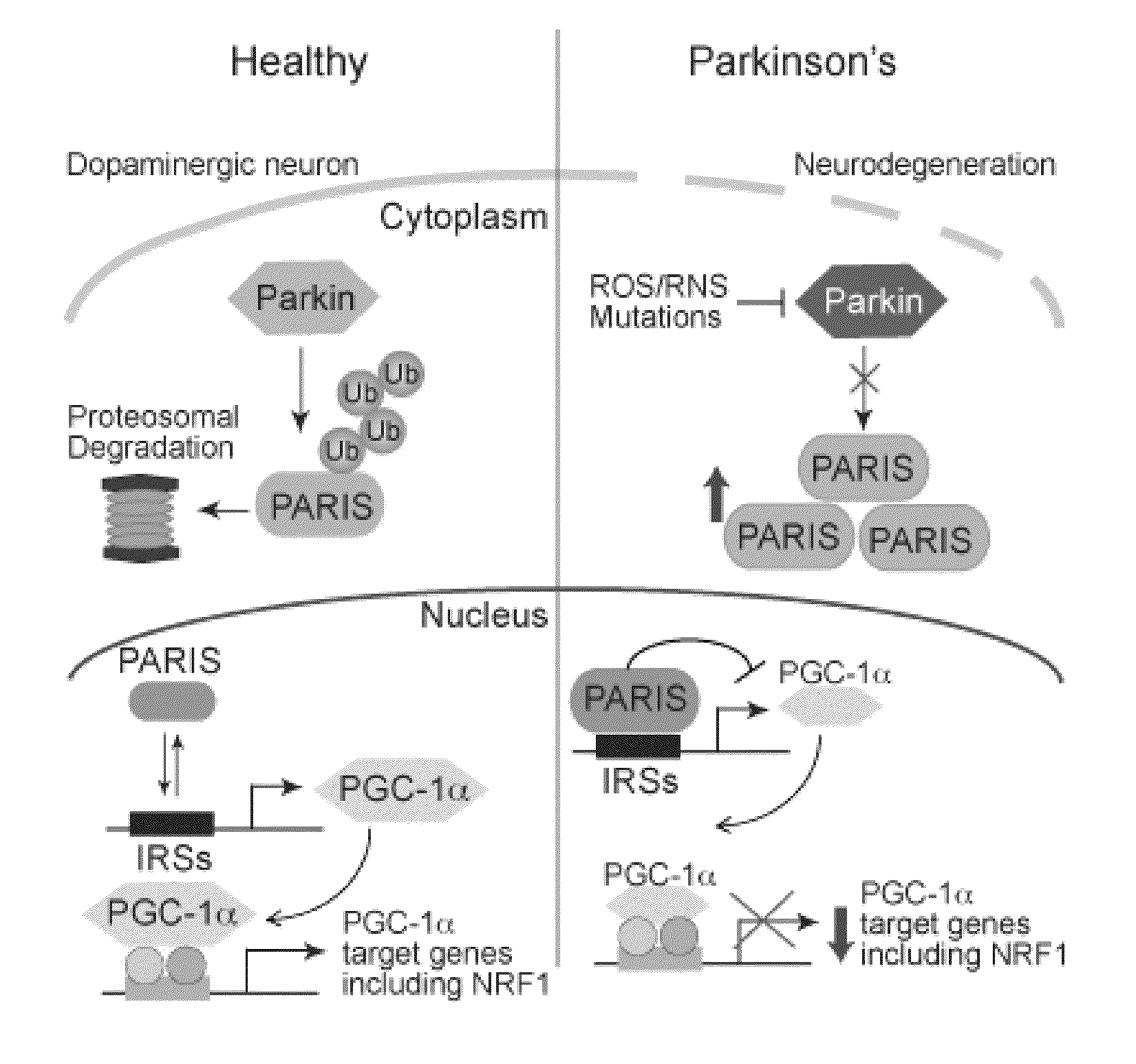Transcriptional repression leading to Parkinson's disease
a transcriptional repression and parkinson's disease technology, applied in the field of parkinson's disease and related disorders, can solve problems such as difficulty in reconciling a common biochemical pathway
- Summary
- Abstract
- Description
- Claims
- Application Information
AI Technical Summary
Problems solved by technology
Method used
Image
Examples
experiment 1
PARIS was a KRAB and C2H2 Zinc Finger Protein
[0323]PARIS was identified by yeast two-hybrid screening using parkin as bait. Human PARIS (ZNF746) was a 644 amino acid protein that contained a Kruppel-associated box (KRAB) at its N-terminus and a C2HC / C2H2 type zinc finger at its C-terminus (FIG. 9). There was a high degree of homology among human, mouse and rat PARIS proteins (FIG. 4) (see Table 1). Northern blot and immunoblot analysis revealed that PARIS was expressed in all organs examined (FIGS. 5 and 6). PARIS was differentially expressed in the brain with low levels in cerebellum and midbrain (FIG. 3). Immunohistochemistry revealed that PARIS was heterogeneously distributed throughout the brain and that it was localized to neurons, including substantia nigra (SN) pars compacta DA containing neurons (FIG. 10). Confocal imaging indicated that PARIS was co-localized with parkin in primary cortical neuron cultures (FIG. 11) and in SH-SY5Y dopaminergic-like cells (FIG. 7). The polyc...
experiment 2
Parkin Interacted with PARIS
[0325]MYC-tagged parkin and FLAG-tagged PARIS co-immunoprecipitated in SH-SY5Y cells, whereas XIAP, a RING finger ubiquitin E3 ligase and ZNF398, a highly conserved homologue of PARIS did not interact with PARIS and parkin, respectively (FIG. 12). Recombinant GST-PARIS pulled down recombinant His-Parkin indicating that PARIS and parkin directly interacted (FIG. 13). The familial PD-associated mutations in parkin, C431F, R275W and Q311X bound to PARIS less avidly than WT parkin, whereas G430D mutant parkin bound to PARIS in a manner similar to WT parkin (FIG. 14). PARIS co-immunoprecipitated with parkin and parkin co-immunoprecipitated with PARIS from whole human striatum (FIG. 15) or mouse brain (FIG. 16). This endogenous interaction between parkin and PARIS was not observed in parkin exon 7 KO brain (FIG. 17) confirming the specificity of the interaction.
[0326]Domain mapping indicated that parkin bound to the C-terminal domain, but not to the N-terminal ...
experiment 3
Parkin Ubiquitinated PARIS and Regulated PARIS Levels
[0327]FLAG-tagged PARIS was ubiquitinated by MYC-tagged parkin in SH-SY5Y cells as shown by the substantial HA immunoreactivity in the form of a smear, which was characteristic of polyubiquitinated proteins (lane 3, FIG. 21). Familial linked parkin mutations C431F, G430D and Q311X have substantially reduced ubiquitination activity against PARIS, whereas R275W had modest activity (FIG. 21). The reduction in ubiquitination of PARIS by these mutants was due, in part, to their reduced binding (see FIG. 14), as well as, reduced E3 ligase activity of these parkin mutants.
[0328]FLAG-PARIS was ubiquitinated in the absence of exogenous parkin (lane 2, FIG. 21 and lane 2, FIG. 22). This endogenous ubiquitination was enhanced with co-expression of WT parkin (lane 3, FIG. 21 and lane 3, FIG. 22). ShRNA-Parkin eliminated the endogenous ubiquitination (lane 4, FIG. 22). To control for potential off-targets effects of shRNA-parkin, a shRNA-resis...
PUM
| Property | Measurement | Unit |
|---|---|---|
| pH | aaaaa | aaaaa |
| pH | aaaaa | aaaaa |
| pH | aaaaa | aaaaa |
Abstract
Description
Claims
Application Information
 Login to View More
Login to View More - R&D
- Intellectual Property
- Life Sciences
- Materials
- Tech Scout
- Unparalleled Data Quality
- Higher Quality Content
- 60% Fewer Hallucinations
Browse by: Latest US Patents, China's latest patents, Technical Efficacy Thesaurus, Application Domain, Technology Topic, Popular Technical Reports.
© 2025 PatSnap. All rights reserved.Legal|Privacy policy|Modern Slavery Act Transparency Statement|Sitemap|About US| Contact US: help@patsnap.com



